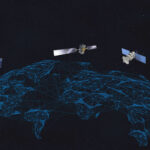Esri has released a new version of its GIS software. ArcGIS Pro 2.7 brings a new data type named 3D object feature classes that can be used for creation of advanced imagery.
The highlights section includes featured functionality updates at this release.
GNSS device location support
You can connect a GNSS (GPS) device to ArcGIS Pro to view the location of your device in a map or scene. As you travel, the location of the device automatically updates in the view.

When location is turned on, you can create features based on the GNSS device’s current geographic location, or set up a point feature class to automatically log data from the device as your position updates.
Mobile geodatabases
The mobile geodatabase is a new type of geodatabase in ArcGIS Pro 2.7. As with other geodatabases, you can create mobile geodatabases to store geographic datasets, perform data modeling tasks, and use as inputs to geoprocessing tools and scripts.

A mobile geodatabase is stored in an SQLite database, which provides the following advantages:
- SQLite is a widely available, stable, and trusted database.
- SQLite is open source and in the public domain, so no licensing is required.
- SQLite databases are supported cross-platform and are stored in a single file on disk, making them portable and an efficient data exchange format.
- SQLite is a full-featured relational database that allows querying and reporting workflows through SQL.
Mobile geodatabases are the first step in allowing fully interoperable workflows between ArcGIS Pro and ArcGIS Runtime, and will lead the way to enhanced workflows and applications in ArcGIS Runtime and the Esri suite of mobile apps.
Layer and feature blending
You can now apply blending modes to layers in your map. For example, you can brighten or darken a layer to bring attention to the highs or lows of a map’s various ranges of color. Commonly used in image editing and graphic design workflows, blending modes can enhance the visualization of features and change the way you design maps for publication.

When a blending mode is applied to a layer, layers below it in the map’s drawing order are visually altered. Most blending modes are applied to each color channel independently.
For further control, you can also apply blending modes to features within a single feature layer. In this case, symbolized features are blended with each other within the layer.
Linear referencing
Routes are used by linear referencing systems (LRS) to model linear distances and related events. They are created as m-aware polyline centerline features with m-values at each vertex that store a measure value independent of the line geometry.
You can now create a route from selected line features, calibrate a selected route using two or more specified calibration points, and define a portion of a linear route by tracing and clicking two points along the route.

The new linear referencing editing capabilities are part of the core ArcGIS Pro application. You don’t need an extension product, such as Roads and Highways or Pipeline Referencing, to use them.
3D object feature layers
3D object feature classes are a new data type in ArcGIS Pro 2.7. Like multipatches, 3D objects represent the outer shells of features that occupy 3D space, but they have a richer set of properties. For example, they can display characteristics such as reflection, shadowing, and roughness. 3D object feature classes are stored in a file, enterprise, or mobile geodatabase. File geodatabase 3D object features can be opened and edited directly in a number of third-party modeling applications, including Maya and Blender.

Sphere represented by a multipatch feature (left) and a 3D object feature (right)
When you add a 3D object feature layer to a scene in ArcGIS Pro, you can use the same editing and analysis tools that work on multipatches. Geoprocessing tools are available to convert multipatch feature classes to 3D object feature classes and vice versa.
Movement analysis tools
Movement tools use point track data to analyze and visualize the movement of objects in space and time. Point track data consists of time-sequenced point locations grouped by unique devices, such as GPS or other mobile devices. Four complementary tools analyze movement:
- Find Cotravelers determines which devices, such as mobile phones, may be traveling together at the same place and time.
- Find Meeting Locations identifies areas where several devices have a longer dwell time—indicating a possible meeting location.
- Compare Areas finds unique devices operating in known areas at the same place and time.
- Classify Movement Events identifies movement-specific events in point track data.

Classify Movement Events is the newest of the four tools. It attributes point track data with turn information (including U-turns), stops, and information about acceleration and deceleration, simplifying the time-consuming process of reviewing track points to figure out how an entity was moving at a location. This is useful for analysts working with shipping telemetry, monitoring feeds from traffic, or reviewing GPS device metrics.
A huge list of all changes and new features of ArcGIS Pro 2.7 can be read at Esri website.
